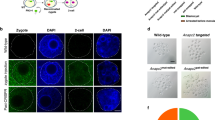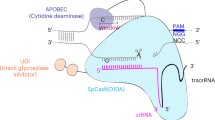Abstract
The zebrafish (Danio rerio) is increasingly being used to study basic vertebrate biology and human disease with a rich array of in vivo genetic and molecular tools. However, the inability to readily modify the genome in a targeted fashion has been a bottleneck in the field. Here we show that improvements in artificial transcription activator-like effector nucleases (TALENs) provide a powerful new approach for targeted zebrafish genome editing and functional genomic applications1,2,3,4,5. Using the GoldyTALEN modified scaffold and zebrafish delivery system, we show that this enhanced TALEN toolkit has a high efficiency in inducing locus-specific DNA breaks in somatic and germline tissues. At some loci, this efficacy approaches 100%, including biallelic conversion in somatic tissues that mimics phenotypes seen using morpholino-based targeted gene knockdowns6. With this updated TALEN system, we successfully used single-stranded DNA oligonucleotides to precisely modify sequences at predefined locations in the zebrafish genome through homology-directed repair, including the introduction of a custom-designed EcoRV site and a modified loxP (mloxP) sequence into somatic tissue in vivo. We further show successful germline transmission of both EcoRV and mloxP engineered chromosomes. This combined approach offers the potential to model genetic variation as well as to generate targeted conditional alleles.
This is a preview of subscription content, access via your institution
Access options
Subscribe to this journal
Receive 51 print issues and online access
$199.00 per year
only $3.90 per issue
Buy this article
- Purchase on Springer Link
- Instant access to full article PDF
Prices may be subject to local taxes which are calculated during checkout





Similar content being viewed by others
References
Huang, P. et al. Heritable gene targeting in zebrafish using customized TALENs. Nature Biotechnol. 29, 699–700 (2011)
Sander, J. D. et al. Targeted gene disruption in somatic zebrafish cells using engineered TALENs. Nature Biotechnol. 29, 697–698 (2011)
Cade, L. et al. Highly efficient generation of heritable zebrafish gene mutations using homo- and heterodimeric TALENs. Nucleic Acids Res. 40, 8001–8010 (2012)
Moore, F. E. et al. Improved somatic mutagenesis in zebrafish using transcription activator-like effector nucleases (TALENs). PLoS ONE 7, e37877 (2012)
Dahlem, T. J. et al. Simple methods for generating and detecting locus-specific mutations induced with TALENs in the zebrafish genome. PLoS Genet. 8, e1002861 (2012)
Nasevicius, A. & Ekker, S. C. Effective targeted gene ‘knockdown’ in zebrafish. Nature Genet. 26, 216–220 (2000)
Doyon, Y. et al. Heritable targeted gene disruption in zebrafish using designed zinc-finger nucleases. Nature Biotechnol. 26, 702–708 (2008)
Meng, X., Noyes, M. B., Zhu, L. J., Lawson, N. D. & Wolfe, S. A. Targeted gene inactivation in zebrafish using engineered zinc-finger nucleases. Nature Biotechnol. 26, 695–701 (2008)
Foley, J. E. et al. Rapid mutation of endogenous zebrafish genes using zinc finger nucleases made by Oligomerized Pool ENgineering (OPEN). PLoS ONE 4, e4348 (2009)
Lawson, N. D. & Wolfe, S. A. Forward and reverse genetic approaches for the analysis of vertebrate development in the zebrafish. Dev. Cell 21, 48–64 (2011)
Moscou, M. J. & Bogdanove, A. J. A simple cipher governs DNA recognition by TAL effectors. Science 326, 1501 (2009)
Boch, J. et al. Breaking the code of DNA binding specificity of TAL-type III effectors. Science 326, 1509–1512 (2009)
Cermak, T. et al. Efficient design and assembly of custom TALEN and other TAL effector-based constructs for DNA targeting. Nucleic Acids Res. 39, e82 (2011)
Bedell, V. M. et al. The lineage-specific gene ponzr1 is essential for zebrafish pronephric and pharyngeal arch development. Development 139, 793–804 (2012)
Miller, J. C. et al. A TALE nuclease architecture for efficient genome editing. Nature Biotechnol. 29, 143–148 (2011)
Mussolino, C. et al. A novel TALE nuclease scaffold enables high genome editing activity in combination with low toxicity. Nucleic Acids Res. 39, 9283–9293 (2011)
Hyatt, T. M. & Ekker, S. C. Vectors and techniques for ectopic gene expression in zebrafish. Methods Cell Biol. 59, 117–126 (1998)
Wang, Y. et al. Moesin1 and Ve-cadherin are required in endothelial cells during in vivo tubulogenesis. Development 137, 3119–3128 (2010)
Lawson, N. D. & Weinstein, B. M. In vivo imaging of embryonic vascular development using transgenic zebrafish. Dev. Biol. 248, 307–318 (2002)
Traver, D. et al. Transplantation and in vivo imaging of multilineage engraftment in zebrafish bloodless mutants. Nature Immunol. 4, 1238–1246 (2003)
Chen, F. et al. High-frequency genome editing using ssDNA oligonucleotides with zinc-finger nucleases. Nature Methods 8, 753–755 (2011)
Radecke, S., Radecke, F., Cathomen, T. & Schwarz, K. Zinc-finger nuclease-induced gene repair with oligodeoxynucleotides: wanted and unwanted target locus modifications. Mol. Ther. 18, 743–753 (2010)
Thomson, J. G., Rucker, E. B., III & Piedrahita, J. A. Mutational analysis of loxP sites for efficient Cre-mediated insertion into genomic DNA. Genesis 36, 162–167 (2003)
Doyon, Y. et al. Enhancing zinc-finger-nuclease activity with improved obligate heterodimeric architectures. Nature Methods 8, 74–79 (2011)
Meeker, N. D., Hutchinson, S. A., Ho, L. & Trede, N. S. Method for isolation of PCR-ready genomic DNA from zebrafish tissues. Biotechniques 43, 610–614 (2007)
Blum, Y. et al. Complex cell rearrangements during intersegmental vessel sprouting and vessel fusion in the zebrafish embryo. Dev. Biol. 316, 312–322 (2008)
Mahfouz, M. M. et al. De novo-engineered transcription activator-like effector (TALE) hybrid nuclease with novel DNA binding specificity creates double-strand breaks. Proc. Natl Acad. Sci. USA 108, 2623–2628 (2011)
Acknowledgements
State of Minnesota grant H001274506 to S.C.E. and D.F.V.; NIH GM63904 to S.C.E.; NIH grant P30DK084567 to S.C.E. and K.J.C.; NIH grant DK083219 to V.M.B.; Mayo Foundation; NIH DA032194 to K.J.C.; NIH grant R41HL108440 to D.F.C. and S.C.F.; NIH grant GM088424 to J.J.E.; NSF grant DBI0923827 to D.F.V.; General Research Fund (HKU771611, HKU771110, HKU769809M) from the Research Grant Council, The University of Hong Kong and the Tang King Yin Research Fund to A.C.M. and A.Y.H.L. We thank G. Davis for discussion on ssDNA use with custom restriction enzymes, H. J. Fadel for in vitro RNA synthesis, and S. Westcot for comments on this manuscript. We thank G. Moulder for help in DNA analyses and members of the Mayo Clinic Zebrafish Core Facility for excellent animal care.
Author information
Authors and Affiliations
Contributions
W.T. designed and constructed full-length pT3TS-Tal vectors targeting Danio rerio crhr1 and crhr2 against exon sequences provided by K.J.C.; D.F.C. and S.C.F. designed and produced the pT3TS-Tal and GoldyTALEN cloning vectors. D.F.C. synthesized crhr1 and crhr2 TALEN mRNA from the pT3TS-Tal vectors. C.G.S. designed and assembled ponzr1 TALENs and transferred TAL repeats from original crhr1 and crhr2 TALEN vectors into GoldyTALEN. T.L.P. and K.J.C. did initial crhr1 TALEN microinjections. T.L.P. performed initial characterization of crhr1 mutagenesis efficiency by PCR and restriction fragment length polymorphism analysis. T.L.P. and K.J.C. microinjected crhr2 TALEN and loxP oligonucleotides. T.L.P. performed initial characterization by PCR demonstrating loxP integration. R.G.K. fully characterized efficiency and sequence of somatic loxP insertions in the crhr2 locus. K.J.C. screened adult fin clips for mloxP integrations into crhr2. T.L.P. screened F1 offspring for mloxP integrations into crhr2 and together with J.M.C. cloned and sequenced integration events. K.J.C. designed experiments associated for crhr1 and crhr2 modification. K.J.C. selected loxP mutant JTZ17 for integration. A.C.M. developed initial zebrafish genetic testing, TALEN cell-free assays, and ssDNA HDR protocols. S.G.P. conducted the cell-free TALEN endonuclease assay. A.Y.H.L. contributed to the design of initial TALEN and ssDNA HDR experiments. Y.W. and J.J.E. conducted biallelic conversion TALEN experiments in somatic and germline tests. D.F.V. and S.C.E. initiated the strategy to use custom restriction enzymes for genome editing in zebrafish. S.C.E. developed the plan for HDR targeting using ssDNAs, conducted overall project design and data analysis, and wrote the initial manuscript text. All authors contributed to manuscript composition. V.M.B. and J.M.C. conducted ponzr1 and crhr1 TALEN scaffold comparison experiments. V.M.B. and K.J.C. designed ssDNA oligonucleotides for HDR experiments. V.M.B. and J.M.C. injected and screened the EcoRV and mloxP HDR experiments at the ponzr1 locus. J.M.C. ran quantitative data assessments and statistical analyses. V.M.B. and J.M.C. made first drafts and legends of Figs 1, 3 and 5. V.M.B. and J.M.C. conducted fin biopsy analyses of the ponzr1 locus. V.M.B. completed the analysis of ponzr1 germline transmission with assistance from J.M.C.
Corresponding author
Ethics declarations
Competing interests
S.C.F., J.J.E., K.J.C. and D.F.V. hold shares in Recombinetics, Inc., a company that uses TALENs for genome modification in large animals. D.F.V. is a listed inventor on a patent application titled “TAL effector-mediated DNA modification” that is co-owned by Iowa State University and the University of Minnesota, and has been licensed to Cellectis, a European biotechnology company.
Supplementary information
Supplementary Information
This file contains Supplementary Figures 1-11, Supplementary Table 1 and legends for Supplementary Movies 1-3. (PDF 1937 kb)
Supplementary Movie 1
This movie shows red blood cell movement through the blood vessels in wild type embryos. (MOV 707 kb)
Supplementary Movie 2
This movie shows red blood cell movement through the blood vessels in cdh5 MO-injected embryos. (MOV 1831 kb)
Supplementary Movie 3
This movie shows red blood cell movement through the blood vessels in cdh5 GoldyTALEN-injected embryos. (MOV 89 kb)
Rights and permissions
About this article
Cite this article
Bedell, V., Wang, Y., Campbell, J. et al. In vivo genome editing using a high-efficiency TALEN system. Nature 491, 114–118 (2012). https://doi.org/10.1038/nature11537
Received:
Accepted:
Published:
Issue Date:
DOI: https://doi.org/10.1038/nature11537
This article is cited by
-
Versatile generation of precise gene edits in bovines using SEGCPN
BMC Biology (2023)
-
Spinal cord repair is modulated by the neurogenic factor Hb-egf under direction of a regeneration-associated enhancer
Nature Communications (2023)
-
Molecular mechanisms by which the HIV-1 latent reservoir is established and therapeutic strategies for its elimination
Archives of Virology (2023)
-
A robust pipeline for efficient knock-in of point mutations and epitope tags in zebrafish using fluorescent PCR based screening
BMC Genomics (2022)
-
Panx1 channels promote both anti- and pro-seizure-like activities in the zebrafish via p2rx7 receptors and ATP signaling
Communications Biology (2022)
Comments
By submitting a comment you agree to abide by our Terms and Community Guidelines. If you find something abusive or that does not comply with our terms or guidelines please flag it as inappropriate.



